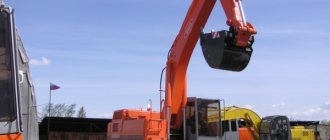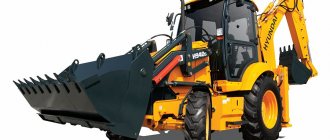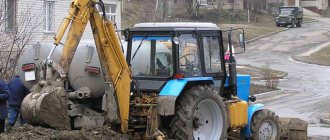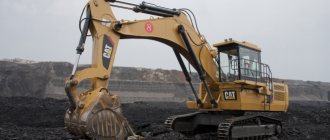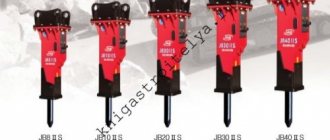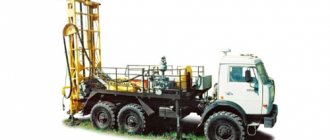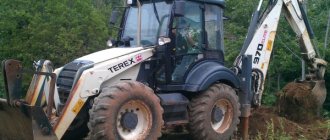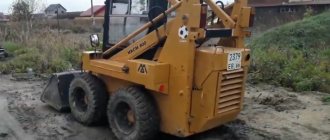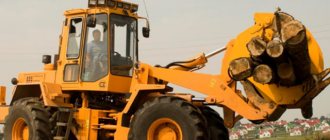Calculation of excavator performance. Options
There are two ways to calculate productivity: experience and reference data. In our company, we imagine what volumes can be counted on for each piece of equipment. You can consult by calling us. Or use reference books for preparing estimates, for example, Moscow TSN-2001 (Territorial estimate standards for Moscow):
for soils of categories 1-3 for development of 100 cubic meters. soil will be swept away (to the dump) with a crawler hydraulic excavator with a 1.0 cubic meter bucket. m. (for example, Hitachi ZX 200, JCB JS 220) 2.2195 machine hours are required, then:
- The excavator's productivity for an 8-hour work shift will be -
360 cc m. The productivity of the excavator with loading into dump trucks is –
From our experience the following data. The backhoe bucket is used for digging trenches and pits. The productivity of soil excavation into the dump under optimal operating conditions is 350 - 400 cubic meters. m per shift for 8 hours. The output varies depending on the digging depth; at the maximum level it decreases by 20%. The complex geometry of excavation work, as well as the need to load soil, reduces productivity by 10 - 15%.
Simpler operations include loading soil from a dump. With proper dispatch of dump trucks, production is within the range of 500 - 600 cubic meters. m.
There is also such an indicator as: the operational performance of an excavator. Its calculation is carried out to determine the efficiency of a mining enterprise based on the results of its activities. Takes into account production, working time utilization rate, and, accordingly, any downtime.
| Photos of equipment | Name | Rent terms | Price per hour | Price per shift |
| Excavator JCB JS 220 bucket 1.2 cubic meters | more than 15 shifts, price including VAT | 2,000 rub. | 16,000 rub. | |
| Excavator Hitachi ZX 200 bucket 1.3 cubic meters. | more than 15 shifts, price including VAT | 2,000 rub. | 16,000 rub. |
Order cubic excavators from our company.
High-performance machines with professional excavator operators. Order
The technical performance of an excavator depends on several factors:
- volume of working equipment. Naturally, the performance of an excavator depends on the volume and purpose of the bucket. Obviously, the larger the bucket, the higher the soil loading speed and the shorter the excavation time. It is necessary to pay attention to the purpose of the bucket, to distinguish, for example, the purpose of a leveling bucket, a trench bucket, a rock bucket, a reinforced bucket, etc.;
- organization of work. Dispatching is the main resource for increasing work productivity. A specialist interested in the result will set up the work in such a way that there will be the smallest possible unloading distance, the best pit development scheme, optimal access for dump trucks and their distribution on the line. The performance of the excavator in this case will be close to operational;
- driver's professionalism. This is probably the main subjective performance parameter. In the practice of our company, almost always an old customer applies for an excavator, subject to the condition of the previous driver. There was a case when two identical excavators from different companies were working at one site, while our company’s machine produced a volume 1.5 times greater, primarily due to the work of our professional driver;
- the novelty of the excavator. Each new model, even within the same brand, is innovative and has increased productivity due to the modernization of components and assemblies and optimization of operations management. The new machine does not break down and does not miss deadlines and tasks;
- soil characteristics. Obviously, the speed of excavation work depends on the severity and hardness of the soil. Also, the water saturation of clays complicates the processes. Viscous, plastic clays do not crumble in the dump truck body, occupying less volume, and stick to the bucket;
- weather. Objective factor - the worse the weather: rain, snowfall, severe frost, the more difficult it is to carry out the work.
We offer JCB / Hitachi crawler excavators for rent for long-term excavation work in the Istra region, Pavlovskaya Sloboda, Krasnogorsk, Nakhabino, Istra, Dedovsk, Snegiry and other cities of the Moscow region.
The productivity of an excavator with a bucket is 1 m3 per hour
Renting out special equipment in St. Petersburg and the Leningrad region. | Topic author: Johnny
We are posting our offers for renting special equipment!
Sergey (Norton) JCB BACKHOE LOADER FOR RENT.
KAMAZ DUMP TRUCK 12cc 972 01 24 Sergey
Vladimir (Anatoliy) Volvo EC 290 excavator (bucket, hydraulic shears, hydraulic hammer) available. Volvo L150 front loader available. weight 26 tons, bucket 4.1 m3. tel. 89111227000. www.ars-spb.ru
Andrey (Noam) Backhoe loader JCB 3СX.9989050 available
Tamara (Robyn)
Semen (Awreja) Rent a JCB4cx backhoe loader, forks 9,700 rubles/cm. We will work conscientiously. Call right now 8 (931) 260-24-25 www.spbtehnika.com
Pavel (Berkley) We do good: we pave roads, territories of children's educational institutions and cottage villages: not expensive and of high quality. We work in St. Petersburg and Leningrad. regions-ASPHALTING-8-965-081-28-91-asphalting St. Petersburg-asphalt laying-asphalt paver rental https://asfalt.blizko.ru/
Svetlana (Dobroslawa) trawl rental in St. Petersburg and outside the Ring Road, size and oversized, up to 40 tons, low-frame, front loading, payment in cash, non-cash. from 110008-905-266-21-90 Svetlana
Sergey (Norton) RENT front loader "Amkodor" TO-18bucket 2 cubes, capacity 3.400kg, unloading height 2.8m, cutting edge width 2.5m.+7(909)577-78-18 Svetlana

Snab (Hildebrand) https://vk.com/betonspb178 subscribe)
Wee (Alvarez) RENT FROM THE OWNER: JCB 3CX backhoe loader, Ivanovets KS-45717K-1 truck crane, 25 ton lifting capacity, MTZ tractor with trailer. (attachments: snow plow and brush) Experienced drivers, all have Russian citizenship and registration in St. Petersburg. Mainly for Leningrad Region facilities - Pushkin, Pavlovsk, Kolpino, Gatchina, Tosnensky district (If you rent in our area, the supply of equipment is free.) We will consider any offers. Tel. 8-960-271-13-29
Vladimir (Anatoliy) Alliance Remstroy LLC (www.ars-spb.ru) dismantling of buildings and structures, excavation work, rental of construction equipment. A Volvo L150 front loader with a 4.1 m3 bucket and a Volvo EC290 excavator with a 1.7 m3 bucket and/or hydraulic shears are available. Tel. 89111227000, Vladimir.
Vadim (Jeremiah) Three trawls are available, one of them is low-frame. Vadim 905-267-6409
Natalya (Quantay) Available Excavator loader JCB 3CX Gatchina
Denis (Hilaria) I will help with the transportation of oversized cargo, my trawls up to 75 tons, St. Petersburg, Leningrad Region, North-West. www.1tk.su. 89119217387 Denis
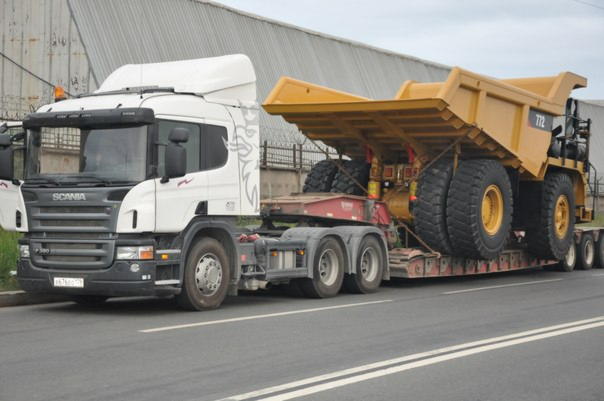
Alyona (Rumi) RENT FROM THE OWNER: trawl rental in St. Petersburg and outside the Ring Road, size and oversized, up to 40 tons, with rear loading, payment in cash, non-cash. from 8000. Permits, support. Alena 8-911-958-10-44. Also a large fleet of its own equipment.
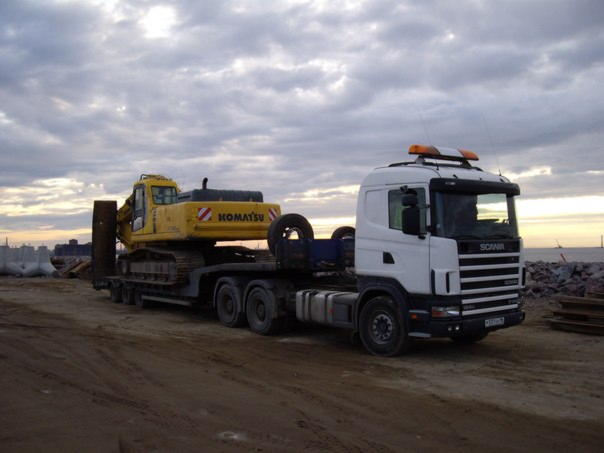
Vladimir (Anatoliy) Free equipment from Alliance Remstroy LLC www.ars-spb.ru 1. Volvo EC290 excavator with hydraulic shears or bucket (1.7 m3). 2. Front loader Volvo L150, bucket 4.1 m3. Tel. 89111227000, Vladimir.
Sergey (Norton) Rent of aerial platforms 17-22-28 meters! Rent of truck cranes 25 tons, 21-28 meters boom! Sergey 89013001433! If suddenly YOU need to hire equipment, then our prices are designed for MUTUALLY BENEFICIAL cooperation, we are ready to consider and discuss all your proposals.
Maxim (Graden) Selling Volvo 210 crawler excavator (swamp) bucket 1, 3 (quick release), track width 900 mm. The equipment is in excellent condition. Year 2007. 89110075009
Vladimir (Anatoliy) Free equipment from Alliance Remstroy LLC www.ars-spb.ru 1. Volvo EC290 excavator with hydraulic shears or bucket (1.7 m3). 2. Front loader Volvo L150, bucket 4.1 m3. Tel. 89111227000, Vladimir.
Tags: Productivity of an excavator with a bucket 1 m3 per hour
Technical parameters of the J8 mini excavator model: Boom rotation angle: 120° Engine power: 9 hp. Honda...
good afternoon, tell me how much in an 8-hour shift an excavator with a bucket capacity of 1 m3 can be developed Nikita | Topic author: Raisa
Natalia per minute two cycles maximum, filling factor 0.9. lunch half an hour. for downtime the coefficient is 0.9. so consider it
uvlechenie.info
Excavator: productivity m3 per hour, cost of services
The need for special equipment services arises in almost every sector of economic activity or for private needs. One-time use of an excavator does not imply its purchase, so you can use the services of a rented excavator. To calculate the cost of services, an indicator of excavator performance is used, which is important when choosing equipment to perform certain jobs, taking into account their urgency and volume.
What is excavator performance
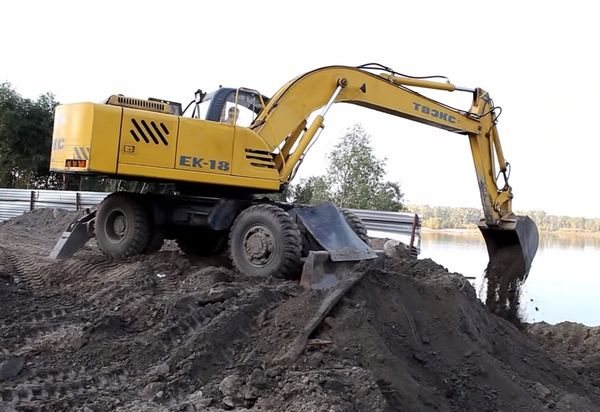
The main function of the excavator is work related to excavation, moving to the unloading site and forming an embankment or unloading. To calculate the performance of an excavator, it is calculated taking into account all the variables and constant indicators in its operation. The productivity of an excavator is the volume and quantity of work that it can perform in a given time period.
The full cycle of operation of an excavator consists of the following steps:
- lowering the bucket;
- soil development;
- putting soil into a bucket;
- lifting a loaded bucket;
- turning with moving the cargo to the unloading point;
- soil unloading;
- returning the bucket to its original position for further work.
The excavator can perform other types of work, but the main essence of the cycle remains the same.
For a more detailed calculation of performance, many variable indicators are taken into account, on the basis of which formulas are compiled. When calculating the performance of an excavator, the following variables and characteristics are taken into account:
- bucket volume;
- number of cycles over a period of time;
- soil loosening coefficient;
- development size factor;
- machine operating coefficient.
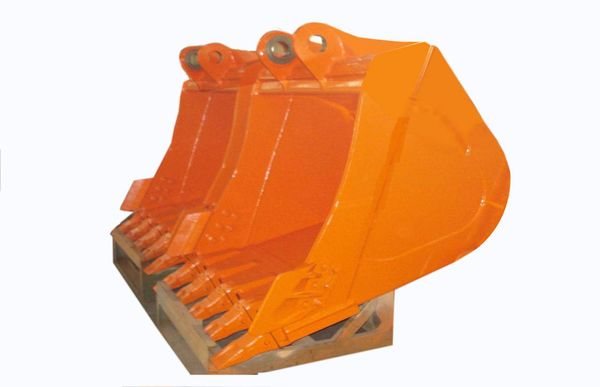
The duration of one full cycle of excavator operation takes several seconds. When calculating productivity, the number of cycles per hour is calculated. The final result is expressed in m3/hour, which is the standard when calculating the productivity of an excavator and further converting this indicator into a shift interval.
How is performance calculated?
Calculations of the efficiency of excavator equipment cannot be unambiguous and take into account all the variables that influence the result.
Therefore, it is common to distinguish between the following three types of performance:
- Theoretical (constructive) - calculation of the amount of work performed by an excavator per hour without taking into account downtime and stops. This is a perfect calculation on paper without taking into account additional variable factors. It is calculated by the formula: Wtheor = Q/Tc, where Q is the volume of the bucket in m3, Tc is the minimum cycle duration in hours.
- Technical – calculation of the largest volume of work, taking into account mining conditions, soil conditions and driver qualifications. It is calculated by the formula: Wtech = Q x Kn/Ttt x Kr, where Q is the volume of the bucket, Ttt is the duration of the work cycle, Kn is the bucket filling coefficient, Kr is the soil loosening coefficient.
- Operational – used to assign standards and carry out general calculations. In the calculations, the machine operating factor is added. This is the closest estimate to actual performance and will always be lower than theoretical or technical performance.
Technical performance
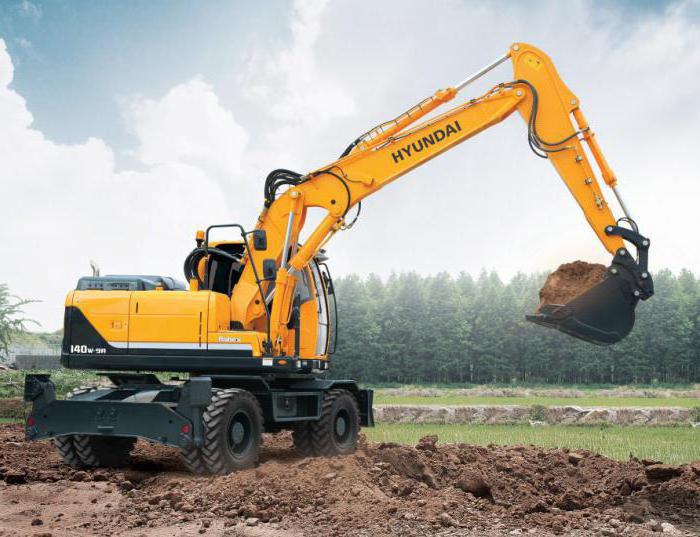
Calculating the performance of an excavator, which is called technical, differs in that the conditions in which the special equipment operates are taken into account. This means that the volume of the bucket, its filling coefficient, as well as the number of cycles are multiplied together, taking into account the operating conditions in a particular place, divided by the soil loosening coefficient. Naturally, all this is also multiplied by sixty to get the result in cubic meters per hour, which is a standard measure of the productivity of excavators specifically. But this does not take into account a very important parameter - the inevitable downtime that occurs during work. There are no conditions in which an excavator could work without the slightest interruption or hitch. This is why you need to calculate the operational productivity of an excavator per hour, since it is closest to reality.
Excavator performance
Excavator productivity is the amount of work performed by the unit in a certain period of time. When calculating, it is divided into theoretical, technical and operational.
Theoretical productivity is the estimated hourly output that a machine can achieve under normal operating conditions at design operating speeds. In general form (at a tilt angle of the excavator platform of 90°), it can be represented by the formula:
where: W teop - theoretical productivity (in m3/hour), q - bucket capacity (in m3), T c - minimum cycle duration under average operating conditions of the excavator (in sec.).
The duration of the operating cycle of the TC consists of a number of individual operations, i.e.
T c = t k +t r +t d +t t +t in +t' r +t' d +t' t +t p +t' p
where: t k - duration of digging (in sec.), t r - duration of acceleration with a loaded bucket (in sec.), t d - duration of uniform movement with a loaded bucket (in sec.), t t - duration of braking with a loaded bucket (in sec.), t in - duration of unloading of the bucket (in sec.), t' p - duration of acceleration with an empty bucket (in juice), t' d - duration of uniform movement with an empty bucket (in sec.), t ' t - duration of braking with an empty bucket (in sec.), t p - total time for turning to the face (in sec.), t' p - total time for turning to unload (in sec.).
Technical productivity is the highest possible output of a machine per hour of continuous operation under certain conditions. It differs from theoretical productivity by taking into account the properties of the soil and the size of the face in which the excavator is used. The influence of the properties of the soil is reflected in the fact that during the separation from the chips, the group is loosened. Therefore, the volume of the ladle is filled with a smaller volume of group than is calculated in a dense body. The influence of soil properties on filling the bucket is taken into account. In addition, if the angle of rotation of the excavator platform is not equal to 90°, then it is necessary to take into account the change in the duration of the cycle.
The cycle duration, and therefore the technical performance of the excavator, is affected by the following:
- soil category (the higher the soil category, the more difficult it is to develop);
- weather conditions (in winter and late autumn, the filling of the bucket with frozen soil decreases due to its sticking to the bucket and freezing on it);
- organization of work and qualifications of an excavator operator.
Technical productivity is determined by the formula:
where: W tech – technical productivity, measured in m3/hour in a dense body, T ct – duration of the excavator operating cycle at the face (in sec.); is determined by timing or is assumed to be equal to T c taking into account the operating conditions, K n is the coefficient of filling the bucket with soil, K p is the coefficient that takes into account the increase in soil volume due to loosening, q is the capacity of the bucket.
The bucket filling coefficient Kn is the ratio of the volume of loosened soil collected into the bucket to the capacity of the bucket; it depends on the design of the bucket and the operating conditions of the excavator; the filling coefficient value is given in table. eleven .
Table 11. The value of the technical productivity coefficients of single-bucket excavators
Greatest analogue K r
I (sandy loam soil) I (peat and plant soil) II (medium loam) III (heavy loam) IV (heavy clay)
Factors Affecting Excavator Performance
Productivity is the main indicator of the work of a mining enterprise; it characterizes the intensity of deposit development and depends on many factors. Its definition is closely related to the development of the theory of design, engineering and improvement of mining technology.
Shift operational productivity ̶ characterizes the productivity of the machine during a work shift, taking into account the use of the machine both in time and in terms of loading (carrying capacity). Based on the production rate for the machine, a production task is set for a day, month, quarter, year.
The main factors affecting excavator performance include the following:
̶ The difficulty of mining a rock mass, which is assessed by the category of the rock and its condition. When mining, for example, wet clay rock that sticks to the bucket, the useful volume of the latter decreases and the cycle time increases due to the longer unloading of the bucket. In winter conditions, poorly crushed frozen soil also reduces the bucket filling factor;
̶ technical data, condition and reliability of the excavator;
̶ quality of the face, assessed by its height, conditions of transport approach to the loading site, lighting;
̶ organization of work depending on the sufficiency of vehicles, road conditions, timely supply of fuel, energy, spare parts, etc.
The productivity of excavators is determined by the number of cubic meters or tons of rock mass (waste rock or minerals) in the ledge pillar, which is extracted per unit of time (hour, shift, day, etc.). When determining the annual productivity of an excavator, the total number of days per year is taken into account, which is usually less than a calendar day due to non-working holidays, downtime for scheduled maintenance, as well as on the occasion of moving to new faces and stopping due to unfavorable climatic conditions, which for cyclic excavators action is extremely rare. There are theoretical (certificate), standard and operational performance of an excavator.
The theoretical productivity of an excavator is the amount of product (in tons or cubic meters) that can be produced per unit of time (usually per hour) during continuous operation. Operating conditions are assumed to be the same for all machines; the coefficients of bucket filling and rock loosening are assumed to be equal to unity. For single-bucket excavators, when calculating theoretical productivity, the following are assumed: the same angle of rotation for unloading, the same height of scooping and the same nominal speed of working movements and specific resistance of rock to digging.
Standard productivity is the amount of work that must be completed using a machine per unit of time. At its core, it corresponds to the operational one. The number of cycles per unit of time (minute) depends on the design features of the excavator, soil conditions, and the shape of the face.
The operational productivity of excavators is the actual volume of rock mass processed by the excavator over a certain period of operation. It is calculated taking into account inevitable organizational and technological downtime: loss of time for accepting a shift and inspecting the machine, lubrication, and replacement of rolling stock. Operational productivity is numerically less than technical. Its value reflects the perfect organization of the work of the excavator and all the machines servicing it.
The operational productivity of excavators can be shift, monthly and annual (in the latter cases, the loss of time for repair inspections, current and major repairs is taken into account). The organization of work at this enterprise (not only in mining, but also in servicing excavators and supplying them with spare parts) is best characterized by the annual productivity of the excavator.
Also, one of the important factors influencing the performance of excavators is the coefficient of soil loosening, which makes it possible to determine the increase in volume during excavation. All soils can be divided into two groups:
̶ Cemented or rocky – stone rocks, the development of which is possible only with the use of explosion or crushing technologies;
̶ Uncemented, the removal of which is carried out manually or using excavators, bulldozers, and other special equipment. These include sands, clays, and mixed types of soils.
The complexity of development and the cost of excavation work are influenced by the following soil properties:
̶ Humidity – the ratio of the mass of water contained in the soil to the mass of solid particles;
̶ Cohesion – shear resistance;
̶ Density, that is, the mass of one cubic meter of soil in its natural state;
̶ Loosening ability – the ability to increase in volume during excavation and development.
The denser and heavier the soil in natural conditions, the more volume it will occupy in the selected state. This parameter affects the volume of soil removal after its development.
Average shift productivity of mining equipment (excavation and loading equipment) in terms of rock mass and the coefficient of utilization of calendar time of mining equipment for 2014. are given in table 1.1.1.
Table 1.1.1
| Type of equipment | Average shift productivity of HPO, m3/per shift | Calendar time utilization rate of HPO, % |
| ECG-8I | 1317 | 80,6 |
| ECG-10 | 2242 | 77,5 |
From Table 1.1.1 it can be seen that the average productivity of the EKG-10 excavator is much greater than the productivity of the EKG-8I. This is explained by the fact that the EKG-10 is a further development of the EKG-8I model and in addition to the main bucket with a capacity of 10 m3 (EKG-8I - 8 m3), the excavator can use replaceable buckets with a capacity of 12.5 and 16 m3. From which we can conclude that the performance of ECG-10 will be greater.
It should be remembered that we do not know and will never know the actual amount of reserves. Even after development is complete, we only know how much we have extracted and not what we have lost. Thus, in the Krivoy Rog basin, one of the iron ore deposits was “completely” mined underground and it was believed that only 17% of the ore was lost. But then a quarry was built at the same deposit and the same amount of ore was extracted as from the mine. Similar cases occurred in the fields of the Kola Peninsula and in Norilsk.
In the process of planning excavation and loading operations, the productivity of the excavator-vehicle complex (EAC) of the quarry is calculated on the basis of the mining and geological characteristics of the rocks in the face, the technical characteristics of excavators and dump trucks, the operating mode of the quarry, the standard duration of working operations, as well as data on the current position of mining works and parameters of technological transportation schemes. The values of these factors are variable, changing in time and space, so the actual performance of the EAC is also a variable value. However, in practice, when planning shifting volumes of work in a quarry, the processes of excavation, loading and transportation are considered as deterministic, i.e. having a predetermined, stable result. This approach often leads to significant discrepancies between the planned and actual shift productivity of the EAC.
For the most part, mining technical factors are parameters of technological schemes for conducting work in quarries (scheme of face - excavator - dump truck - route - unloading point) and their values according to various technological schemes are dynamic in nature. Obviously, the risk of failure to fulfill the shift plan by the excavator-vehicle complex will depend on the magnitude of the risk of a decrease in productivity for each model of equipment on a specific technological scheme, taking into account a possible decrease in productivity due to the poor technical condition of the equipment. This means that, knowing in advance the combination of equipment models in technological schemes (excavator-dump truck combination), it is possible to calculate the expected level of risk of failure to complete shift assignments for these equipment models, and therefore determine the possible productivity of the complex as a whole. To do this, it is necessary to know the maximum permissible level of risk, which can be determined based on the results of technical and economic calculations in the conditions of a particular enterprise, or, according to the recommendations of A.I. Arsentiev, accept based on the function of fear, based on the psychological aspects of decision making. Thus, having established an acceptable level of risk, it is possible to control the performance of the excavator-vehicle complex in the planning process and, when obtaining an estimated performance corresponding to a risk level higher than the maximum permissible indicator, lower performance values corresponding to a lower level of risk are accepted for calculation.
GENERAL PROVISIONS
1.1. These standards are intended to calculate the needs of construction ministries and departments for basic machines for the construction of new facilities related to the relevant sector of the national economy.
1.2. The standards given in table. 1 – 6, set at 1 million rubles. construction and installation work carried out by ministries and departments on their own at prices introduced on January 1, 1969. The standards also take into account the need for machines of manufacturing enterprises on the construction balance sheet.
Note: The need for machines of manufacturing enterprises on the industrial balance sheet is determined by a separate calculation.
1.3. The standards were determined based on the average 1975 indicators of the use of machines, the structure of the mechanization method and the physical volume of work per 1 million rubles. construction and installation works.
Introduced
by the Central Research and Design-Experimental Institute of Organization, Mechanization and Technical Assistance to Construction of the USSR State Construction Committee.
Approved
by the USSR State Construction Committee Decree on April 25, 1977 No. 49 in agreement with the USSR State Planning Committee.
Date of entry into force January 1, 1978.
1.4.
The need for construction machines P when performing construction and installation work for a particular sector of the national economy or industry is determined by multiplying the volume of construction and installation work by the corresponding requirement norm given in Table. 16 :
where О is the volume of construction and installation work carried out on our own, million rubles;
N – the norm of demand for this type of machine per 1 million rubles. construction and installation works, units of the main parameter or pieces.
1.5.
The need for certain types of construction machines when carrying out construction for several sectors of the national economy or industry is determined by calculation using the formula
, (2)
where U is the share of construction and installation work in this industry in the total volume of work, %.
1.6.
If the physical volume of work per 1 million rubles changes. construction and installation work, the structure of mechanization methods and the annual production of machines compared to 1975. The need for machines, calculated according to formula (1), can be adjusted.
The specified PC requirement in this case is determined by the formula
, (3)
where Ko is a coefficient that takes into account the change in the physical volume of work by 1 million rubles. construction and installation works, determined by dividing the volume of work by 1 million rubles. planned (calculated) year for the volume of work in 1975;
K c – coefficient that takes into account changes in the structure of mechanization methods, determined by dividing the specific weight, %, of a given method of work in the total volume of work for the planned (calculated) year by the corresponding indicator for 1975;
K in is a coefficient that takes into account the change in the annual production of machines, determined by dividing the production of machines of the planned (calculated) year by the actual production of machines in 1975.
1.7.
If necessary, the required number of certain types of earth-moving machines, as well as jib and tower cranes, calculated according to the standards, can be replaced by an equivalent number (in terms of productivity) of other types of machines performing similar work.
